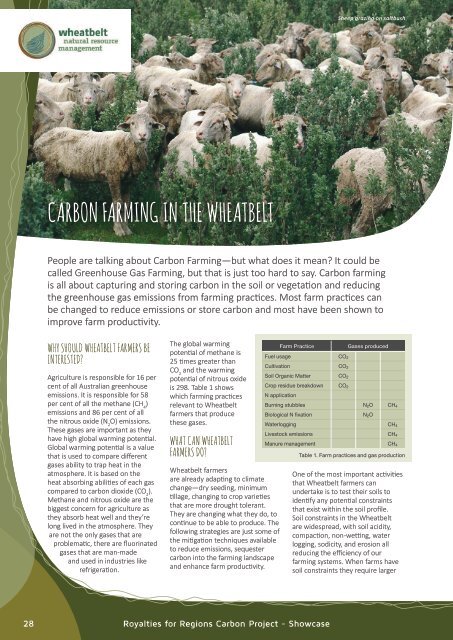Royalties for RegionS Carbon Project - showcase
R4R%20Carbon%20Magazine%20Aug16
R4R%20Carbon%20Magazine%20Aug16
You also want an ePaper? Increase the reach of your titles
YUMPU automatically turns print PDFs into web optimized ePapers that Google loves.
Sheep grazing on saltbush<br />
<strong>Carbon</strong> Farming in the Wheatbelt<br />
People are talking about <strong>Carbon</strong> Farming—but what does it mean? It could be<br />
called Greenhouse Gas Farming, but that is just too hard to say. <strong>Carbon</strong> farming<br />
is all about capturing and storing carbon in the soil or vegetation and reducing<br />
the greenhouse gas emissions from farming practices. Most farm practices can<br />
be changed to reduce emissions or store carbon and most have been shown to<br />
improve farm productivity.<br />
Why should Wheatbelt farmers be<br />
interested?<br />
Agriculture is responsible <strong>for</strong> 16 per<br />
cent of all Australian greenhouse<br />
emissions. It is responsible <strong>for</strong> 58<br />
per cent of all the methane (CH 4<br />
)<br />
emissions and 86 per cent of all<br />
the nitrous oxide (N 2<br />
O) emissions.<br />
These gases are important as they<br />
have high global warming potential.<br />
Global warming potential is a value<br />
that is used to compare different<br />
gases ability to trap heat in the<br />
atmosphere. It is based on the<br />
heat absorbing abilities of each gas<br />
compared to carbon dioxide (CO 2<br />
).<br />
Methane and nitrous oxide are the<br />
biggest concern <strong>for</strong> agriculture as<br />
they absorb heat well and they’re<br />
long lived in the atmosphere. They<br />
are not the only gases that are<br />
problematic, there are fluorinated<br />
gases that are man-made<br />
and used in industries like<br />
refrigeration.<br />
The global warming<br />
potential of methane is<br />
25 times greater than<br />
CO 2<br />
and the warming<br />
potential of nitrous oxide<br />
is 298. Table 1 shows<br />
which farming practices<br />
relevant to Wheatbelt<br />
farmers that produce<br />
these gases.<br />
What can Wheatbelt<br />
farmers do?<br />
Wheatbelt farmers<br />
are already adapting to climate<br />
change—dry seeding, minimum<br />
tillage, changing to crop varieties<br />
that are more drought tolerant.<br />
They are changing what they do, to<br />
continue to be able to produce. The<br />
following strategies are just some of<br />
the mitigation techniques available<br />
to reduce emissions, sequester<br />
carbon into the farming landscape<br />
and enhance farm productivity.<br />
Farm Practice<br />
Fuel usage CO 2<br />
Cultivation CO 2<br />
Soil Organic Matter CO 2<br />
Gases produced<br />
Crop residue breakdown CO 2<br />
N application<br />
Burning stubbles N 2 O CH 4<br />
Biological N fixation<br />
N 2 O<br />
Waterlogging CH 4<br />
Livestock emissions CH 4<br />
Manure management CH 4<br />
Table 1. Farm practices and gas production<br />
One of the most important activities<br />
that Wheatbelt farmers can<br />
undertake is to test their soils to<br />
identify any potential constraints<br />
that exist within the soil profile.<br />
Soil constraints in the Wheatbelt<br />
are widespread, with soil acidity,<br />
compaction, non-wetting, water<br />
logging, sodicity, and erosion all<br />
reducing the efficiency of our<br />
farming systems. When farms have<br />
soil constraints they require larger<br />
28<br />
<strong>Royalties</strong> <strong>for</strong> Regions <strong>Carbon</strong> <strong>Project</strong> - Showcase


